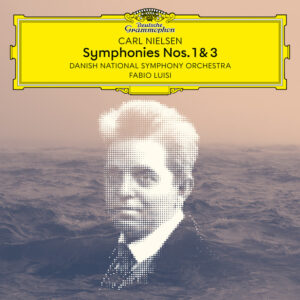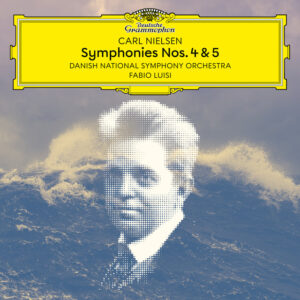GRAMOPHONE Review: Nielsen Symphonies 1 & 3, 4 & 5 – Danish National Symphony Orchestra/Luisi
 These are quite marvellous – and in the case of the Fourth Symphony, incendiary – performances. There’s something about the temperament of the Danish National Symphony Orchestra when they rejoice in the bracing and songful adventures of their favourite son and with an Italian at the helm there is further assurance that this music will sing.
These are quite marvellous – and in the case of the Fourth Symphony, incendiary – performances. There’s something about the temperament of the Danish National Symphony Orchestra when they rejoice in the bracing and songful adventures of their favourite son and with an Italian at the helm there is further assurance that this music will sing.
The fledgling First Symphony already has the spirit of the open air about it and there is that very particular melodic tinta which immediately identifies itself as only one composer. You hear it in the slow movement and you hear it in the chorale-like transformation of the main theme at the close of the scherzo. Luisi relishes things like that and there is that rhythmic sense of music always revving up for lift off.
That impression is almost literally conveyed in the stuttering opening chords of the Third Symphony where one automatically calls to mind Leonard Bernstein and the Royal Danish Orchestra and their joyride on this gigantic carousel of a first movement. Like Bernstein (who, I’d say, is trumped here), Luisi revels in the gaudiness of the hip-swaying waltz theme as it spins into the climax with descanting horns quite unapologetic of their (vulgar) abandon. And then the magic casements opening to enchanted horizons in the slow movement with its wordless chanting of two solo voices (Fatma Said and Palle Knudsen). Lontano is an Italian word so Luis’s gets the remoteness of it all but equally he gets the operatic intensity of the string invocation at the heart of the movement. The big tune of the finale has never sounded more like a distant relative of Brahms in the finale of his First Symphony.
 And so to the blistering opening of the Fourth Symphony ‘Inextinguishable’ which is truly elemental and the most exciting account of the piece I’ve heard since Martinon and Chicago back in the day. It’s that fierce rhythmic drive, that imperative, and the sense that these players have the wherewithal to push the music as far as Luisi wants to take it. As for the piece itself – it’s not just the games it plays with tonality but the constant surprises it springs, the unorthodoxy of its developmental and textural ideas. The little gavotte which briefly charms us in the second movement is a case in point but at the opposite extreme there’s the searing string oration of the slow movement starkly punctuated by timpani (a premonition of the penalty shoot-out to come in the finale).
And so to the blistering opening of the Fourth Symphony ‘Inextinguishable’ which is truly elemental and the most exciting account of the piece I’ve heard since Martinon and Chicago back in the day. It’s that fierce rhythmic drive, that imperative, and the sense that these players have the wherewithal to push the music as far as Luisi wants to take it. As for the piece itself – it’s not just the games it plays with tonality but the constant surprises it springs, the unorthodoxy of its developmental and textural ideas. The little gavotte which briefly charms us in the second movement is a case in point but at the opposite extreme there’s the searing string oration of the slow movement starkly punctuated by timpani (a premonition of the penalty shoot-out to come in the finale).
The headlong fugue into that finale is so exciting and the seismic excitement of duelling timpani is as punchy as needs be. But it’s the return of the harassed but indomitable main theme of the symphony that needs to be absolutely incandescent – and it is. Thrilling.
Which leaves (for now) the still greater originality of the Fifth, tentatively starting as it does with a sequence of oscillations unlike anything in symphonic literature. We are in no-man’s-land and seemingly going nowhere. Enter then the renegade side drum and an all-seeing, all-knowing clarinet which assumes the role of observer. And enter, too, an aspiring string theme which seems to have the words ‘we will overcome’ written across it. Luisi and his Danes work this material into a scarifying climax though for me the side drummer doesn’t go quite far enough with the craziness of his improvised bars – or as Nielsen directs ‘as if at all costs to stop the progress of the orchestra’. I’m not advocating rim-shots (a la the LSO drummer for Horenstein) but there must at least be a hint of demonic possession. The solo clarinet certainly conveys that in the self-destructing dance of death that is the scherzo.
But make no mistake, this is right up there with Bernstein’s New York version and like Bernstein Luisi and his band are more than mindful of American connotations with the rugged terrain of this music and the jazziness and bluesyness of the solo clarinet writing. The coda of the finale could almost be Copland and my goodness does Luisi make capital of the peeling horns which ring out in triumph.
I await symphonies 2 and 6 with impatience.
You May Also Like

COMPARING NOTES: Oliver Savile in conversation
03/02/2021
COMPARING NOTES WITH LEWIS CORNAY
20/04/2021

